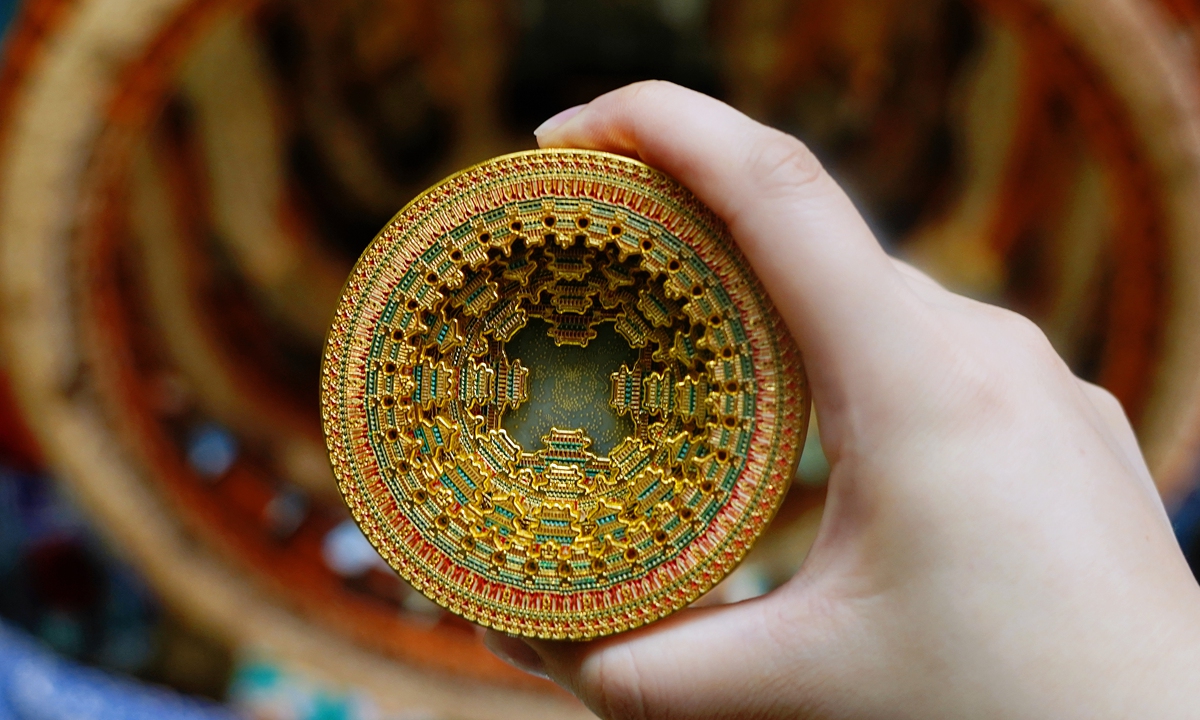
A magnet souvenir of the Beijing Ancient Architecture Museum Photo: Beijing Ancient Architecture Museum
Intricately designed "phoenix crown" fridge decorations, luminous ceiling designs, and delicate "pink furnace" pieces are the latest viral museum souvenirs in China. Inspired by iconic artifacts, these cultural products have become highly sought-after collectibles.
Experts note that small, creative cultural products, drawing on China's long history and rich cultural resources, have become a key driver in the development of the cultural tourism industry.
To get their hands on these high-demand items, thousands of consumers across China have become dedicated "magnet hunters," carefully studying online release times and sharing "purchase guides" on social media.
On one popular e-commerce platform, a much-coveted fridge magnet inspired by a phoenix crown from the Ming Dynasty (1368-1644), one of the National Museum's most treasured artifacts, is released at 8 pm every evening, with only 200 of them available each day.
Similarly, visitors line up early in the morning at the National Museum in Beijing to wait for the museum's cultural shop to open and allow limited sales. Every day, only 1,000 customers are given the chance to buy the magnet, with a strict limit of two per person.
Since its launch in July, sales of this product reached nearly 80,000 units as of the end of October, with related products like badges, bookmarks, and keychains pushing total sales to over 10 million yuan ($1.4 million), according to the Xinhua News Agency.
Other museums across China are seeing similar trends. The Beijing Ancient Architecture Museum's caisson ceiling, the Hangzhou Museum's green-glazed porcelain cups, and the Shaanxi History Museum's painted bronze lamps and more are being recreated in miniature form and becoming popular among young people, who often share their excitement on social media platforms.
Behind the rise of these small cultural products is the strong support of outstanding Chinese traditional culture.
These cultural and creative products draw on China's long history and rich cultural resources, extracting, transforming, and reimagining cultural elements.
They combine modern aesthetics with practical functionality, striking a deep resonance with consumers' love and recognition of traditional culture.
So, for many, these items are more than just souvenirs - they represent a tangible connection to China's rich cultural heritage.
Wang, a user of the social media platform Xiaohongshu, explained to the Global Times that she buys a fridge magnet every time she visits a museum. For her, these fridge magnets are not only affordable but also visually appealing and a great way to commemorate the unique characteristics of each museum.
Experts believe these small cultural products have a powerful emotional appeal, particularly among younger generations seeking a deeper connection with China's past.
Bu Xiting, an associate researcher with the School of Cultural Industries Management at the Communication University of China, told the Global Times, "These products not only provide emotional resonance and value but also meet consumers' desire for personalized and culturally immersive experiences."
Many cultural products in recent years have tapped into China's deep cultural heritage, blending uniqueness, artistry, and practicality, making them especially appealing to young consumers, he added.
By the end of 2023, China had nearly 9,645 cultural institutions, including 6,833 museums and memorials. In 2023 alone, these institutions hosted 30,000 exhibitions, drawing over 1.4 billion visitors, according to Xinhua.
"Small cultural products have become a new highlight in driving the development of cultural tourism," said Bu.
"By meeting the diverse needs of consumers, enhancing multi-dimensional travel experiences, creating new job opportunities, and promoting innovation in cultural tourism technology, cultural products will play an even more significant role in driving the high-quality development of the cultural tourism industry in the future."
The author is a reporter with the Global Times. life@globaltimes.com.cn




